The World of Non-sensuous Similarity: Keisuke Matsuda’s Painting
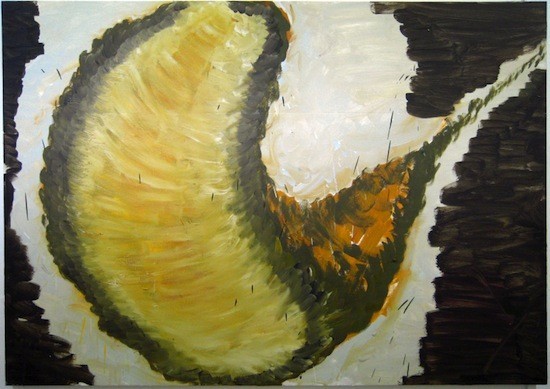 Keisuke Matsuda – Untitled (2008). All images: Courtesy the artist.
Keisuke Matsuda – Untitled (2008). All images: Courtesy the artist.When viewing an artist’s work for the first time, we inevitably measure their individuality according to some kind of standard of “proficiency.” This is usually either a standard of painterly technique or a standard of knowledge of the history of painting. Those who tend towards the former respond more to well-made paintings that demonstrate the free use of distinctive techniques or the kinds of beautiful abstract paintings that can only be produced by people with a thorough knowledge of oil paint, for example, whereas those who tend towards the latter try to read artists from the past, art history and so on behind what is actually depicted on the canvas. In a sense, “proficiency” is the same as comprehensibility. It guarantees the substance of a painting. The reason why “proficient” painters are fundamentally comprehensible is that they can answer the question, “What are you trying to do with this painting?” In the case of a beautiful abstract painting, the answer may be, “Conveying a mood or atmosphere,” or, “It has no meaning; it’s just a pure expression of the beauty of strokes and colors,” and in the case of a conceptual painting the answer may be, “It’s a reference to so-and-so’s work,” or, “It’s about the conditions for the realization of an illusion,” and so on.
What about in the case of a skillfully executed well-made painting? For example, a painting of a woman in which individual strands of hair are depicted as densely compacted lines. Here, the thing people appreciate is the monomaniac painterly skill of the artist, not the thing represented in the form of the woman.(1) To be asked, “Of what is this a painting?” and reply, “A woman,” would be nonsensical. In other words, it isn’t a representational painting. Because the technique is what constitutes the artist’s identity, and the question “Of what?” is secondary. Of course, one could say that technique and subject are inseparable, but in this example it wasn’t that the miniaturist technique had to be used in order to depict the woman’s hair; on the contrary, the woman was only chosen as the subject in order to use the miniaturist technique. In these kinds of technical paintings, the real content is not in fact the thing depicted, but the specific effect arising from the technique.
That “proficient” paintings measured against a standard are tedious is due to the fact that the “paintings” themselves recede from view on account of this “proficiency.” To put it another way, in response to the question, “Of what is this a painting?” the artist concerned can only respond in a roundabout way by referring not to the painting itself but to their own concept or technique, by saying, for example, “I’m expressing such-and-such (beauty, a concept, an effect).”
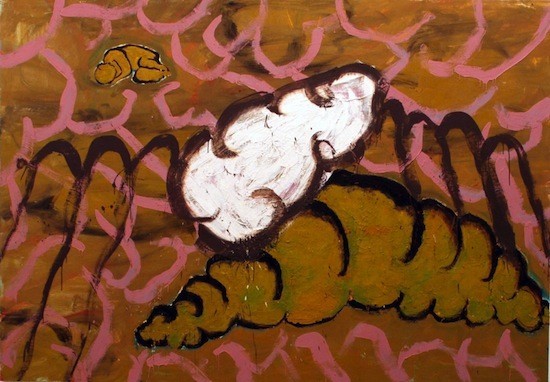 Keisuke Matsuda – Untitled (2009).
Keisuke Matsuda – Untitled (2009). To those who are tired of proficient, comprehensible paintings, let me recommend Keisuke Matsuda.(2) Matsuda’s work is completely devoid of the kinds of merits we usually use as standards to gauge the proficiency of a painting. Crude supports, paint used in a way reminiscent of a beginner in oil painting, an extreme lack of concern for technique, indiscernible figures – whether we deem them abstract paintings or representational paintings, ultimately people will likely burst out laughing at the succession of obscure shapes that may or may not resemble sprawling sea slugs (?), ancient Venuses (?), bananas (?), rectums (?), and while it could be said that a distinctive palette of muddy colors, powerful brush strokes and splashes of paint are all observable, there appears to be a complete absence of intent for these to constitute an autonomous picture plane. When applied to Matsuda’s work, familiar standards of “proficiency” seem not to function adequately. And herein lies his unparalleled individuality.(3) So, “of what” are Keisuke Matsuda’s paintings?
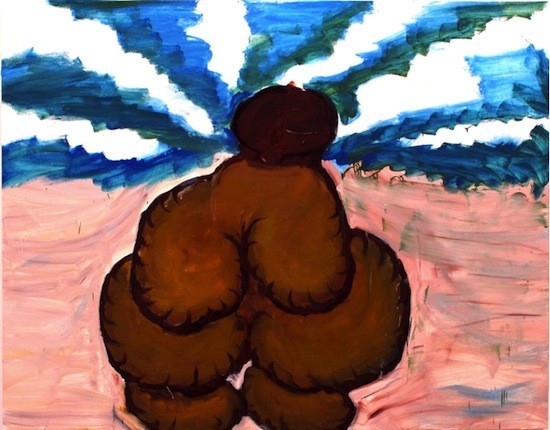 Keisuke Matsuda – Untitled (2009).
Keisuke Matsuda – Untitled (2009). 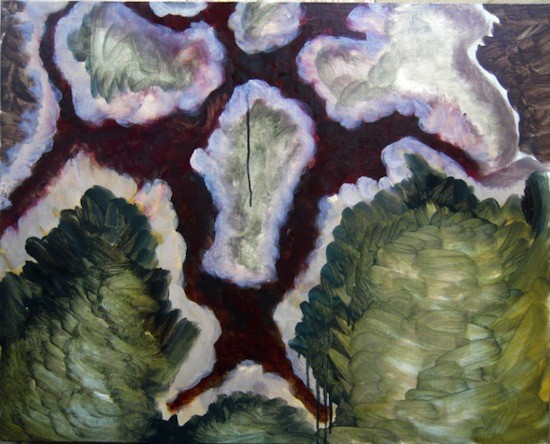 Keisuke Matsuda – Untitled (2010).
Keisuke Matsuda – Untitled (2010). Matsuda’s past three solo exhibitions (eN arts, Kyoto, 2009, 2011, 2012) all bear the same title: “WORDS LIE.” Thinking it might be one of those not uncommon titles where, to quote the song lyric, “it will sound untrue if it is put into words,”(4) I asked the artist what it meant. The answer was somewhat unexpected. “WORDS” refers to the format “I’m expressing such-and-such” favored by the kinds of artists referred to above. In other words, regardless of what technique is applied to the act of “painting,” and regardless of what it seems is being expressed, everything expressed by way of the format “so-and-so (subject) does such-and-such (object)” is condemned as a lie.
Does this mean that Matsuda views his own paintings as something other than representation, or in other words, as paintings of presence in which the real – or surreal – state of the world manifests itself? This, too, is not such an uncommon argument. Regardless of the difference in terminology,(5) however, ultimately an “artist” paints “something” on a canvas, but when I asked if his explanation was not strained, Matsuda replied that his paintings were not surreal or anything, but that he simply depicts the world. Keisuke Matsuda’s creative process is remarkable. He concentrates in his atelier, whereupon the world and his self contract until they suddenly collapse giving rise to a condition in which oneself = the world. The next moment the world separates again but there remains inside him an impression of his contact with it. These traces are volatile, as it were, and gradually fade. Matsuda hurriedly traces their outline before they vanish completely, and the results are his artwork. As a student he borrowed stopgap forms (human figures, faces, and so on) in an effort to prolong the amount of time the traces remained, but in recent years he has managed to capture the traces on canvas in their pure form. According to Matsuda, the experience of the condition in which “oneself = the world” that precedes the separation of subject and object is the reason why he continues to paint.
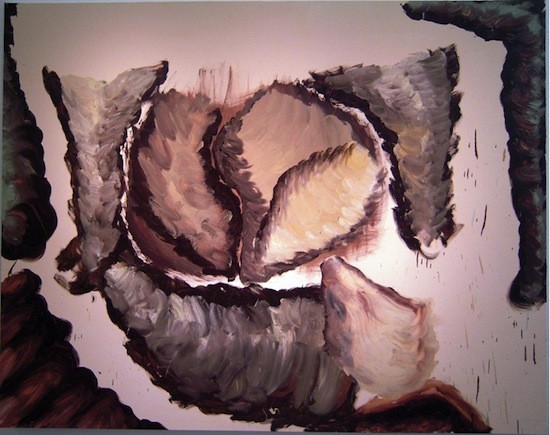 Keisuke Matsuda – Untitled (2011).
Keisuke Matsuda – Untitled (2011). 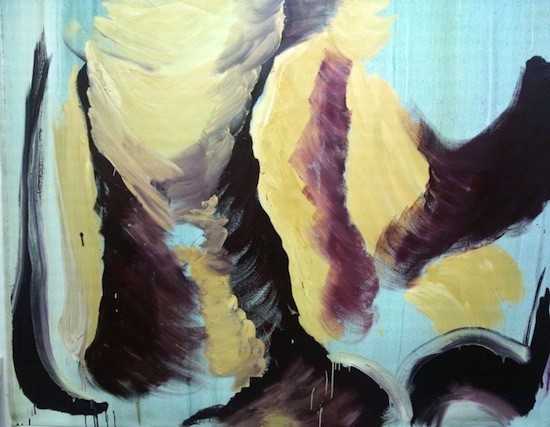 Keisuke Matsuda – Untitled (2012).
Keisuke Matsuda – Untitled (2012). The secondary significance of technique; the rough, brisk strokes and marks that follow the outlines of volatile forms; the absence of composition premised on a frame; shapes that are basically devoid of top, bottom, left and right; the trimming-like method whereby the canvases are stretched over frames after being painted… the characteristics of Matsuda’s paintings are a natural consequence of his creative process. Rather than a phenomenological epoché (suspension of judgment) or the satori (enlightenment) of Zen, I am reminded of a story from Walter Benjamin’s childhood. The story describes a child holding his breath while waiting in a hiding place during a game of hide-and-seek.
(Hiding) Here I was enveloped in the world of matter. It became monstrously distinct for me, loomed speechlessly near. […] The child who stands behind the doorway curtain himself becomes something white that flutters, a ghost. […] Whoever discovered me … could weave me as a ghost for all time into the curtain…. Indeed without waiting for the moment of discovery, [I] would anticipate its arrival with a cry of self-liberation.(6)
While holding his breath in his hiding place, the child feels himself merging with the world of matter. Holding his breath in his atelier, Matsuda appears to become one with the world before breaking out and uttering a cry of self-liberation by producing a painting. In another essay by Benjamin, such paintings are called “hieroglyphics.” Here he is referring to the letters children scribble on pictures and observing also a form of “compression.”
And if, in the colored engraving, children’s imaginations can fall into reverie, the black-and-white woodcut or the plain prosaic illustration draws them out of themselves. With the same compelling demand for a description that is found in such images, they awake the word in the child. Just as the child describes these images in words, so too will they “write” them in a more literal sense: they will scribble on them. Unlike the colored pictures, the surface of the black-and-white illustration seems to be incomplete and hence [it affords a certain compression]. So the children [compress letters and illustrations]. At the same time that they learn language from them, they also learn writing: hieroglyphics.(7)
Unable to tolerate the “false” question, “Of what is this a painting?” the child compresses the distance between the subject (so-and-so) and the object (such-and-such) and scribbles words. This gives rise to hieroglyphics in the form of writing in which symbol and meaning have collapsed into one, which are prototypes of actual writing. Presently the compression diminishes, and when the subject and object separate into two forms producing the enduring correspondence “so-and-so means such-and-such,” the system of language comes into existence. What Benjamin focuses his attention on, however, is the prototype of this in which symbols (writing and pictures) emerge prior to the formation of language. Benjamin uses the term “non-sensuous similarity” to refer to the condition in which symbols take on a meaning over and above the symbols themselves, or to put it another way, when the symbols themselves resemble their meaning. By “non-sensuous” he means that unlike colors and shapes, the similarity is not one that appeals to the senses. Writing is the realm of non-sensuous similarity. Or as Benjamin puts is, “Script has thus become, like language, an archive of nonsensuous correspondences.”(8)
We adults who acquired language and means of expression long ago live habitually in the world of “so-and-so does such-and-such” (the world of “lies”). At certain moments, however, “compression” occurs and we experience the onset of a primitive, unseparated state, or in other words non-sensuous similarity. This is a volatile similarity that comes to us in a flash before vanishing again.
Rather, the mimetic element in language can, like a flame, manifest itself only through a kind of bearer. […] [T]hrough which, like a flash, similarity appears. For its production by man – like its perception by him – is in many cases, and particularly the most important, limited to flashes. It flits past.(9)
Matsuda’s paintings are non-sensuous imitations of the world, or “paintings that depict the state of I=world.” If “proficient” artists reiterate paintings following their formation as a system, then Keisuke Matsuda reiterates a primitive state prior to this formation in which pictures (letters and pictures) emerge. These pictures are “flames” that manifest themselves inside the artist as “a kind of bearer.” We negotiate the talkativeness of “proficient” paintings and arrive back to be confronted with the silence of Matsuda’s works. This is the scene of the act of “painting” that predates our learning to say “someone” did “something,” and having witnessed this we recall just how much freedom there was in painting.
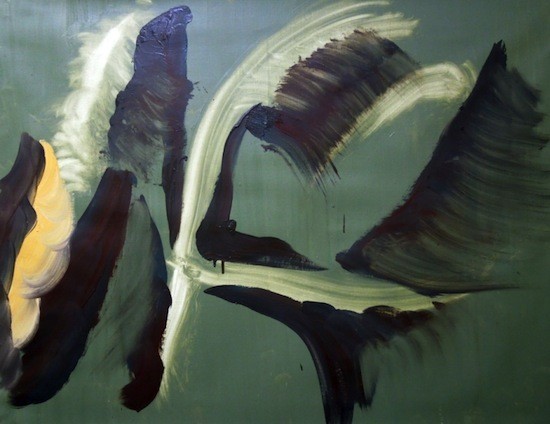 Keisuke Matsuda – Untitled (2012).
Keisuke Matsuda – Untitled (2012). 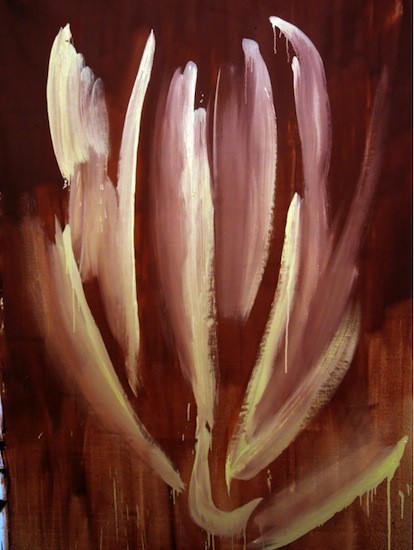 Keisuke Matsuda – Untitled (2012).
Keisuke Matsuda – Untitled (2012). Keisuke Matsuda’s “WORDS LIE” was on display at eN arts, Kyoto, from February 3 to 26, 2012.
-
Of course, there are some people who like any kind of picture as long as it is of “young girls,” “Mount Fuji,” “nudes” or “flowers,” but here the issue is “the individuality of an artist viewed for the first time,” so these cases are excluded.
- Born 1984; MFA from Kyoto City University of Arts and recipient of the Naoki Sato Prize at Art Award Tokyo both in 2009.
- Looking through one of the definitive catalogs of painting by emerging artists, Bob Nickas’s Painting Abstraction: New Elements In Abstract Painting (Phaidon, 2009), for example, there are really no artists that resemble Matsuda. Those who look at Matsuda’s work and are reminded of the likes of Enzo Cucchi, Arshile Gorky or via a kind of “shynesss” of Philip Guston, would probably realize that they are wrong if they looked again at books of paintings by these artists.
- Lyrics from the Monta & Brothers hit song “Dancing All Night.”
- “Le figuritif” versus “le figural” and so on.
- Walter Benjamin, “Hiding Places” in Berlin Childhood Around 1900, trans. Howard Eiland (Harvard University Press, 2006) 99-100. Passages in square brackets my translation of the original German.
- Walter Benjamin, “A Glimpse into the World of Children’s Books” in Walter Benjamin: Selected Writings, 1913–1926, vol. 1, trans. Rodney Livingstone (Harvard University Press, 1996) 436. The compression of signifier and signified can also be seen in the work of Jean Genet. “If the king’s banner, borne by a galloping horseman appears alone, we may be moved, may bare our heads; if the king were to carry it himself, we may be crushed! The foreshortening [compression] preferred by the symbol when borne by that which it signifies gives and destroys the signification and the thing signified.” [Jean Genet, The Thief’s Journal (Paris: Olympia Press, 2004) 158-159.]
- Walter Benjamin, “On Mimetic Faculty” in Reflections: Essays, Aphorisms, Autobiographical Writings (New York: Schoken Books, 1986) 334.
- Ibid. 335.
